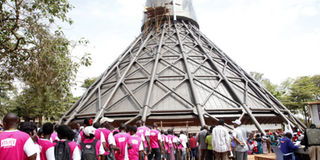The transformation of Uganda Martyrs Shrine

Visitors line up outside the Uganda Martyrs Shrine, Namugongo, currently under renovation. PHOTO BY RACHEL MABALA
At different points of the Uganda Martyrs Shrine, Namugongo, groups of men and women go about their work, either manning machines or manually digging or fixing something.
The shrine is a busy place. And as workers go about working day and sometimes at night, there are locals prying on them, mesmerised at the work at hand and the changes it has brought to the holy grounds.
The Basilica is something to marvel about. It has been rebuilt with stronger metallic fasteners and at the top are glasses which will allow natural light into the shrine for those praying to comfortably enjoy mass. Originally the top was built with aluminium.
For now, the interior of the Catholic shrine is empty as works go on. From the outside, you can see some supporting construction ladders. The church’s floor has been redone and it has a new shine. There are two new confession boxes.
On the outside, a young man is busy with a brush, putting vanish on rectangular bricks and running green paint in the concrete joints.
The shrine is taped off, from visitors, to allow work smoothly go on. Fr Vincent Lubega, of Missionaries of Africa and rector of the shrine, says much as Roko Construction Company Limited still has a lot of work to do, they are nearing the completion of the project to repair and rebuild the shrine and its sites.
Roko’s chief executive officer, Mark Koehler, says they have employed 744 workers on site, adding that they will be joined by Uganda People’s Defence Forces this week.
The reconstruction project is worth Shs2.3b. “Much of the funds have been injected towards construction of the pavilion, site for the pond and the Basilica,” Koehler says, adding that they are soon completing the works and handing over the site.
Fr Lubega explains that the shades under the trees are going to be terraced. This will be a better set up without the roots that used to inconvenience believers as they made the grounds uneven on a steep terrain.
The grounds are being levelled and grass will be planted. People will be able to sit comfortably as they attend mass or take a rest at the Catholic shrine.
The pond from which believers used to draw holy water has been excavated. “We have razed the lake, removed all the rubbish and redone the walls of the Lake. By the time the Holy Father comes, we would have put back the water,” Fr Lubega explains.
The altar has been moved too. It used be located at the beginning of the lake. It has been moved to the back of the lake and it is now suspended on pillars, with a long bridge. It looks beautiful. Those intending to have their marriages held at the shrine, the lake will be one of the places to look out for, given its beautiful ambience.
Sanitation has been an issue at the shrine grounds. A number of toilets have been constructed at different points. “We have built nine toilets and each has 28 units. We hope all this will be complete by the time the Pope comes. Roko Construction is working very hard,” Fr Lubega explains.
He reveals that the Holy Father will conduct mass from the podium, over the lake. He adds: “There are three pavilions that have been built over the water, one for the very important people, priests and leaders. The one for the priests is located behind the lake.”
The shrine is regarded holy. Fr Lubega explains that the altar in the Basilica is the most holy site because it is where Charles Lwanga was beheaded.
“That is where his blood was spilled. Charles Lwanga was not burnt, but was beheaded on his way to Nakiyanja. His head fell where the altar was built. Those who come to the shrine make sure they enter the Basilica and pray in front of the altar,” he adds.
He also explains that the shrine grounds are holy grounds because people stood for their faith and shed their blood at the location.
Indeed, Pope Francis’ visit puts a lot of focus on the Uganda Martyrs who are annually commemorated, on June 3, at the same grounds. Pilgrims from different parts of the country and the world converge at the holy sites to say prayers.
About Martyrs Shrine
The shrine is located some 15km east of the capital city - Kampala. They are popular as Catholic and Anglican sites for the martyrs that were killed at the orders of Kabaka Danieri Basammula-Ekkere Mwanga Mukasa II between November 1885 and January 1887.
In his book, African Holocaust, John F. Faupel writes that within 10 years of their first knowledge of the Catholic Faith, 22 boys and men of Uganda laid down their lives for their religion.
He goes on to write that Mwanga took power, changing the relationship between Buganda and the missionaries. He notes that the young king lacked the character his father Kabaka Mutesa, who invited the missionaries, had.
He undid what his father had initiated. He sent away the missionaries.
Years after the voluntary deaths and canonisation 51 years ago, big numbers throng the shrine grounds on June 3 the day set aside to commemorate them.
Uganda Tourism Board (UTB) has recently seen an opportunity to tap into religious tourism. UTB is a government agency with the responsibility of promoting and marketing Uganda as the preferred tourism destination.
Its deputy director, John Ssempebwa, says Uganda receives more than 3,000 pilgrims on June 3 every year for the Uganda Martyrs Day celebrations in Namugongo.
“We have never advertised Martyrs Day in any of those countries. This is a one-off and importantly we are treating this as faith-based tourism. For the first time we have the Protestants and Muslims on board,” he added.
UTB’s public relations officer, Vincent Mugaba, says although pilgrims throng Namugongo to pay tribute to the Uganda Martyrs, trekking their route could yield a lot of results in a bid to promote faith-based tourism. It covers Munyonyo, Nsambya, Owino Market (St Balikuddembe) and all the way to Rubaga Cathedral.
“By going through the Martyrs trail, you will get to know that special heritage we hold in our nation Uganda. You will have the opportunity to see the different monuments, pray at the shrines, read the stories, and even see the places you may have never thought were so special to you. For example, how many know there is a museum at Rubaga Cathedral? Yet many pray or pass by the premises regularly,” he expounds.
He says it has not been possible to estimate exactly how many locals throng Namugongo but estimates that they are in excess of one million people. He says Martyrs Day is a big opportunity to market Uganda.
About the Namugongo Catholic Shrine
The biggest activities take place at the Catholic shrine referred to by the locals as Namugongo because it’s here that Charles Lwanga met his death over a slow fire.
The former Katikkiro (prime minister) of Buganda, Tefero Kisosonkole, himself a survivor of the holocaust, donated the land to Catholic Church in 1935.
The late Emmanuel Cardinal Nsubuga Kiwanuka, then Archbishop of Kampala, began the work of building the shrine, in the shape of a traditional Baganda hut. He raised funds at both local and international levels.
Dr Danhinden did the architectural work and the construction was by M/S Roko Construction Ltd. Work begun in 1967 and was completed in 1975.
The church stands on 22 copper pillars representing the 22 Catholic Martyrs, while the doors’ surfaces are curved in the story of martyrdom by Zairean (now DR Congo) artist Joseph Mazambi. The curving depicts the suffering the martyrs endured.
Inside the shrine are 22 stained glass pictures with the names of the martyrs and in one corner is the image of young Kizito being baptised by Charles Lwanga on the eve of their arrest at Munyonyo.
Right in front of the main entrance is the altar, which was consecrated by Pope Paul VI on August 2, 1969. It stands at the spot marked with a concrete star where the then leader of the Catholic Church in Buganda, Charles Lwanga, was burnt over a slow fire on the morning of June 3, 1886.
The Pope also blessed the stone on which the names of 22 Catholic Martyrs are engraved.
It’s outside the main entrance.
The construction was completed in 1975 and the shrine was blessed and the Holy Father sent Sergio Cardinal Pignedoli to officially open the shrine on June 3, 1975.
Below the shrine down in the valley is a man-made lake from which pilgrims collect holy water in which the martyrs’ blood was washed. The parishioners of Namugongo dug the lake from 1954 to 1980 led by Msgr. Lawrence Mbwega, the first parish priest of Namugongo.
The rectangular lake has pavilions at both sides and a platform in the middle where mass is celebrated. Trees that give a serene atmosphere to pilgrims during mass and relaxation surround it.
The shrine is normally open for people who want to see inside throughout the week. There is someone to lead you around on request.
Tom Malaba
Source: The story of the Uganda Martrys published
by Fountain Publishers




